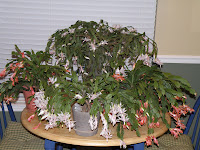
Tea olives are some of the most sweetly fragrant plants in Southern gardens. The word Osmanthus is derived from Greek osma, meaning "fragrant", and anthos, meaning, "flower". That description is very accurate of the Osmanthus fragrans I planted in my yard! This may be their most fragrant year since I planted them. Tea olives grow as dense, evergreen shrubs or small trees and are long-lived and virtually pest free. Occasional disease and insect problems can develop, mainly under stressful conditions. I transplanted 3 shrubs this spring that had been in the ground for 5 years and they are blooming right along with the ones that have been in the same spot for 5 years.
I would never have guessed such tiny flowers could fill my yard with such a wonderful scent often being compared to the scent of peaches, orange blossoms or jasmine. I started out with 4 Fragrant Tea Olive (O. fragrans) when my local county extension agent mentioned the wonderful shrub/tree in a Master Gardener class in 2004. I was given two more from a neighbor who said his wife was allergic. My daughter-in-law was visiting from Colorado and immediately on stepping outside asked about the wonderful scent. I showed her the tiny flowers producing the wonderful smell and like me she was surprised. I love this almost carefree plant it blooms heavily in the fall (about 2 month) and also has scattered blooming through winter and into the spring. My flowers are creamy yellow. Some produce white flowers. There are several cultivars, mostly chosen for flower color (including orange). While some are still uncommon, they are well worth the search.
CultureWild olive is an adaptable, slow growing little tree that thrives in almost any soil and needs no attention once established.
Light: Partial shade to full sun. Wild olive does very well in light, dappled shade, and even in almost full shade.
Moisture: Once established, wild olive is drought tolerant. It also can tolerate moist soils, and even an occasional flooding.
Hardiness: USDA Zones 5 - 9. Although its native range is restricted to USDA zones 8 and 9, wild olive is known to be hardy in zone 5. This is the most cold hardy of the cultivated Osmanthus species.
Propagation: Seeds should be cleaned and planted outside as soon as ripe; they usually take two years to germinate. Tip cuttings from half ripe wood taken in summer can be rooted under glass.











































